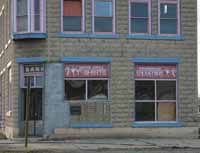| A Main Street restoration project in Green River could include the removal of old buildings. The former bank building is structurally unsafe. |
The Green River Chamber of Commerce sponsored the first Green River Economic Summit on Feb. 22. One of the breakout workshops was conducted by Ed Meyer who is the director of the state of Utah’s Office of Rural Development. Ed Meyer has been involved in a variety of positions related to economic development.
In Meyer’s training session he asked who is Green River’s main competition. Participants mentioned Moab and Salt Lake. In the workshop, the participants listed ideas under four main categories. S.W.O.T. was introduced as strengths, weaknesses, opportunities and threats. Strengths people listed included: open space, motels, scenic views, state parks, the Green River, accessibility etc.
The weaknesses listed included workforce, remoteness, infrastructure, lack of confidence, lack of funding, opposition to change, nonsupport of local business, lack of governmental support, child care, marketing and advertising.
Meyer instructed not to worry too much about weaknesses, because a lot of it you can’t do anything about anyway; so why spend time and energy worrying about it. He said we need to look for ways to enhance the local economy and to get businesses and the community to work together. “You need to bring together people who are willing to help,” said Meyer. He said that overpopulation in other parts of the state can lead to opportunities for Green River to attract some of those people and businesses who are looking to relocate. People and businesses need to know what’s available in Green River and what incentives and enticements might attract a business here. A list needs to be compiled of the package available and what is available at a state and federal level for economic development in rural communities.
The question of what rural really means was discussed. To someone from Los Angeles, Cedar City is still a rural area; but, to someone from Green River, Cedar City should not qualify as a rural area anymore. Meyer said there are indicators to determine if an area is still rural such as if it still utilizes agriculture as an industry, availability of natural resources and measuring population density.
This group discussion centered around being open to new ideas and attractions to bring people into Green River.
| The revitalization of Green River and its downtown area was discussed at the summit. |
Activities at the shooting range, new business at the industrial park, welcoming dirt bikes, mountain bikers and motorcycle clubs were all mentioned. The possibility of a wind farm could be looked at as well as a training area for homeland security with the wide-open space and the former missile base site.
Meyer also had the group analyze what they viewed as threats to being successful. Some items listed included: unwillingness to change and progress, lack of motivation, funding and support. The group decided that lack of an economic development committee in the city was a hinderance to progress. A lack of available housing should a business choose to relocate to Green River also poses a problem. Other threats listed were aging population, lack of know how and the need for better business contacts.
Meyer said when people do come into Green River, you need to address how they can help the community and what connections they might have. Native sons and daughters might want to return to the area and bring a business or an idea for a business with them.
One idea also presented was marketing Green River to the aging population as a retirement place.
Retirees have the expertise and energy to participate in a community and add to its appeal.
Meyer instructed the group to package and sell the community. “Differentiate yourselves from the crowd,” he said.

